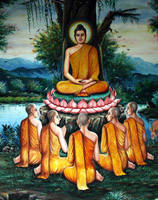
The historical Buddha began his spiritual quest by seeking highly regarded gurus of his day. Then he realized enlightenment, and disciples began to follow him.
Leaving Home
The Buddha and his first disciples had no fixed place to call home. They slept under trees and begged for all of their food. Their only clothes were robes they patched together from cloth taken from rubbish heaps. The cloth usually was dyed with spices such as turmeric or saffron, which gave it a yellow-orange color. Buddhist monks’ robes to this day often are called “saffron robes.”
At first, people who wished to become disciples simply approached the Buddha and asked to be ordained, and the Buddha would grant ordination. As the sangha grew, the Buddha established a rule that ordinations could take place in the presence of ten ordained monks without his having to be there.
In time there came to be two steps to ordination. The first step was home-leaving. Candidates recited the Ti Samana Gamana (Pali), “taking the three refuges” in the Buddha, the dharma, and the sangha. Then the novices shaved their heads and put on their patched, yellow-orange robes.
The Ten Cardinal Precepts
Novices also agreed to follow the Ten Cardinal Precepts, which are:
- 1. No killing
- 2. No stealing
- 3. No sexual intercourse
- 4. No lying
- 5. No taking of intoxicants
- 6. No eating at the wrong time (after the midday meal)
- 7. No dancing or music
- 8. No wearing of jewelry or cosmetics
- 9. No sleeping on raised beds
- 10. No acceptance of money
These ten rules eventually were expanded to 227 rules, recorded in the Vinaya-pitaka of the Pali Canon.
Full Ordination
In time a novice could apply for full ordination as a monk. To qualify he had to meet certain standards of health and character. Then a senior monk presented the candidate to the assembly of monks and asked three times if anyone objected to his ordination. If there were no objections, he would then be ordained.
The only possessions monks were allowed to keep were three robes, one alms bowl, one razor, one needle, one girdle, and one water strainer. Most of the time they slept under trees. They begged for their food in the morning and ate one meal a day, at noon. Monks were to gratefully receive and eat whatever they were given, with a few exceptions. They could not store food or save anything to eat later. For more on the food rules for monks, see “Buddhism and Vegetarianism.”
The Buddha also ordained women as nuns. For the story of the first Buddhist nuns and the rules they followed, please see “The First Buddhist Women.”
Discipline
As explained earlier, monks endeavored to live by the Ten Cardinal Precepts and the other rules of the Vinaya-pitaka. The Vinaya also prescribes penalties, ranging from simple confession to permanent explusion from the order. On days of a new and full moon, monks gathered in an assembly to recite the canon of rules. After each rule was recited, the monks paused to allow for confessions of breaking the rule.
Rains Retreats
The first Buddhist monks sought shelter during the rainy season, which lasted most of the summer. It came to be the practice that groups of monks would stay somewhere together, forming a temporary community. Wealthy laypeople sometimes invited groups of monks to be housed on their estates during the rainy seasons. Eventually a few of these patrons built permanent houses for monks, which amounted to an early form of monastery.
In much of southeast Asia today, Theravada monks observe Vassa, a three-month “rains retreat.” During Vassa, monks remain in their monasteries and intensify their meditation practice. Laypeople participate by bringing them food and other supplies. Elsewhere in Asia, many Mahayana sects also observe some form of three-month intensive practice period to respect the rains retreat tradition of the first monks.
Growth of the Sangha
The historical Buddha is said to have delivered his first sermon to only five men. By the end of his life, the early texts describe thousands of followers. Assuming these accounts are accurate, how did the Buddha’s teachings spread?
The historical Buddha traveled and taught, through cities and villages, during the last 40 or so years of his life. Small groups of monks also traveled on their own to teach the dharma. They would enter a village to beg for alms, going from house to house. People impressed by their peaceful, respectful nature often would follow them and ask questions.
When the Buddha died, his disciples carefully preserved and memorized his sermons and sayings and passed them on to new generations. Through the dedication of the first Buddhist monks, the dharma is alive for us today.
By Barbara O’Brien
Source : buddhism.about.com




